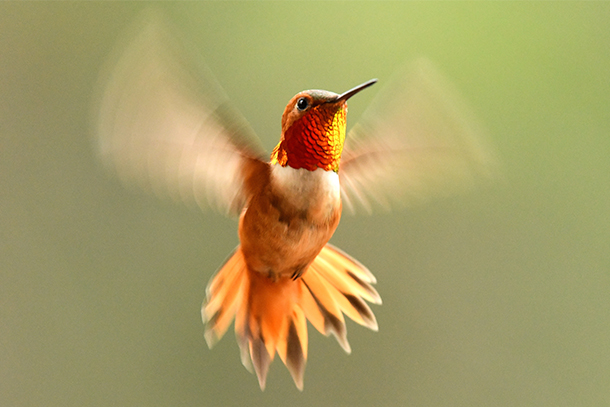
Hummingbirds have extreme aerial agility and flight forms, which is why many drones and other aerial vehicles are designed to mimic hummingbird movement. Using a novel modeling method, researchers gained new insights into how hummingbirds produce wing movement, which could lead to design improvements in flying robots. iStock/mlharing
Hummingbird flight could provide insights for biomimicry in aerial vehicles
The small bird’s mechanics revealed through a novel modeling method
December 9, 2022
By Sarah Small
UNIVERSITY PARK, Pa. — Hummingbirds occupy a unique place in nature: They fly like insects but have the musculoskeletal system of birds. According to Bo Cheng, the Kenneth K. and Olivia J. Kuo Early Career Associate Professor in Mechanical Engineering at Penn State, hummingbirds have extreme aerial agility and flight forms, which is why many drones and other aerial vehicles are designed to mimic hummingbird movement. Using a novel modeling method, Cheng and his team of researchers gained new insights into how hummingbirds produce wing movement, which could lead to design improvements in flying robots.
Their results were published this week in the Proceedings of Royal Society B.
“We essentially reverse-engineered the inner working of the wing musculoskeletal system — how the muscles and skeleton work in hummingbirds to flap the wings,” said first author and Penn State mechanical engineering graduate student Suyash Agrawal. “The traditional methods have mostly focused on measuring activity of a bird or insect when they are in natural flight or in an artificial environment where flight-like conditions are simulated. But most insects and, among birds specifically, hummingbirds are very small. The data that we can get from those measurements are limited.”
The researchers used muscle anatomy literature, computational fluid dynamics simulation data and wing-skeletal movement information captured using micro-CT and X-ray methods to inform their model. They also used an optimization algorithm based on evolutionary strategies, known as the genetic algorithm, to calibrate the parameters of the model. According to the researchers, their approach is the first to integrate these disparate parts for biological fliers.
“We can simulate the whole reconstructed motion of the hummingbird wing and then simulate all the flows and forces generated by the flapping wing, including all the pressure acting on the wing,” Cheng said. “From that, we are able to back-calculate the required total muscular torque that is needed to flap the wing. And that torque is something we use to calibrate our model.”
With this model, the researchers uncovered previously unknown principles of hummingbird wing actuation.
The first discovery, according to Cheng, was that hummingbirds’ primary muscles, that is, their flight engines, do not simply flap their wings in a simple back and forth motion, but instead pull their wings in three directions: up and down, back and forth, and twisting — or pitching — of the wing. The researchers also found that hummingbirds tighten their shoulder joints in both the up-and-down direction and the pitch direction using multiple smaller muscles.
“It’s like when we do fitness training and a trainer says to tighten your core to be more agile,” Cheng said. “We found that hummingbirds are using similar kind of a mechanism. They tighten their wings in the pitch and up-down directions but keep the wing loose along the back-and-forth direction, so their wings appear to be flapping back and forth only while their power muscles, or their flight engines, are actually pulling the wings in all three directions. In this way, the wings have very good agility in the up and down motion as well as the twist motion.”
While Cheng emphasized that the results from the optimized model are predictions that will need validation, he said that it has implications for technological development of aerial vehicles.
“Even though the technology is not there yet to fully mimic hummingbird flight, our work provides essential principles for informed mimicry of hummingbirds hopefully for the next generation of agile aerial systems,” he said.
The other authors were Zafar Anwar, a doctoral student in the Penn State Department of Mechanical Engineering; Bret W. Tobalske of the Division of Biological Sciences at the University of Montana; Haoxiang Luo of the Department of Mechanical Engineering at Vanderbilt University; and Tyson L. Hedrick of the Department of Biology at the University of North Carolina.
The Office of Naval Research funded this work.



